In Addition
Vol 11 Izdaja 3
Maj/Junij 2020
1. Health tips
Spice your day in a healthy way!
"The food we consume should be tasty, sustaining, and pleasant. It should not be too hot or too salty; there must be a balance and equilibrium maintained. It should not arouse or deaden. Rajasic food enrages the emotions; Tamasic food induces sloth and sleep. Satvic food satisfies but does not inflame the passions or sharpen the emotions.” …Sri Sathya Sai Baba1
What is a Spice?
Spice is the dried part of a plant, other than leaves called herbs but not covered in this article. It could be a seed or fruit pod (mustard, cumin, coriander, fenugreek, carom, nigella, nutmeg, fennel, anise, star anise, and cardamom); bark (cinnamon and mace), dried bud ( clove), flower stigma (saffron), berry (peppercorn, allspice), root or rhizome (ginger, turmeric), resin (asafoetida), or bulb (garlic).2,3
Usage, benefits, and storage of spices
Usage: Spices are used since ancient times for seasoning, flavouring, or garnishing a recipe, as they are aromatic and lend a special flavour, taste, and sometimes colour too! Fresh spices, whole or ground, may be fried or roasted first and then added to a dish near the end of cooking or just before serving to retain the flavour and aroma in food. They can also be added earlier in the cooking process to make them more absorbable. They are good preservatives too as they can inhibit the growth of pathogens in food and enhance their shelf-life.4,5
Benefits: Almost all the spices are rich in antioxidants, minerals like calcium, magnesium, potassium, phosphorous, trace minerals like iron, manganese, copper, selenium, as well as vitamins, amino acids, and some with omega-3 fatty acids, in addition to carbohydrates, protein, and fibre. They are considered potent with healing power due to their antifungal, antiviral, anti-microbial, anti-inflammatory, antiseptic, anaesthetic, and analgesic properties. So, they are beneficially used in ancient and traditional systems of medicine. Though research has been inadequate to clinically prove the effect, some studies as well as practices have revealed that spices nourish the body, enhance the mood, and can prevent and treat diseases, even life threatening ones like cancer, diabetes, stroke, and coronary heart disease.2,4,5,8
Storage: With time spices do lose their aroma and flavour. So, store them in air tight containers away from sources of heat and moisture so that seeds will last for up to 2 years and powdered spices can last up to 1 year.2,4
Caution: Spices are beneficial and safe only in small quantities, normally 1 teaspoon (2 to 2.5 g) per day but sometimes only a pinch or two. People with medical conditions and pregnant and breast-feeding women should consult their doctor regarding the intake of spices and their quantity.2,8
Specific spices
There are more than 100 varieties of spices,5 but we are covering only commonly known 20, Indian names are given in parenthesis.
1. Mustard seeds (Sarso, Rai)
These seeds are best sautéed until they pop, before adding other aromatic ingredients. Powdered seeds can be sprinkled on a salad or warm dish, or added to condiments and pickles. Mustard paste made from overnight soaked seeds is also popular.
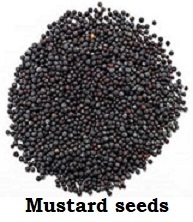 Rich in many minerals and omega-3 fatty acids, it can eliminate intestinal parasites, heal the bronchial system, promote blood circulation to ease skeletal and muscular pains, sprains, and spasms, and also help in healing psoriasis and contact dermatitis.
Rich in many minerals and omega-3 fatty acids, it can eliminate intestinal parasites, heal the bronchial system, promote blood circulation to ease skeletal and muscular pains, sprains, and spasms, and also help in healing psoriasis and contact dermatitis.
External application: Patients with sore throats can gargle with tea made from mustard seeds. Adding mustard powder to a foot soak can relieve chest congestion. A mustard poultice can be applied to the body to ease bronchitis, bronchial pneumonia, pleurisy, and all pains. As a cleaning tool, scrub the mixture of a few bruised mustard seeds with water and vinegar on dirty pots and pans, allow it to stand overnight, and wash the pot or pan thoroughly the next day.
Caution: Up to 2 g per day is considered safe. People with thyroid, kidney, or gallbladder problems should consult their doctor.6,7
2. Cumin seeds (Jeera)
In some cultures cooking cannot be complete without the earthy, nutty, spicy, and warm cumin seeds sautéed and added to vegetables, soup, lentils, or any rice or millet preparation. Its powder can enhance the taste of yoghurt and buttermilk.
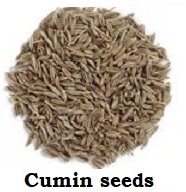 Rich in iron, calcium, and vitamins A & C, it can prevent and help in curing anaemia, food-borne viral infections, insomnia, and osteoporosis, regulate blood pressure, detoxify liver, promote digestion, lower blood sugar, boost the immune system, and improve energy level. One study revealed obese women who consumed a high dose of cumin powder in yoghurt at 2 meals daily for 3 months had significant decrease in body weight and fat and stabilised their HDL/LDL cholesterol ratio; in another study, there was a decrease in insulin level in 8 weeks. 4,8,9,10
Rich in iron, calcium, and vitamins A & C, it can prevent and help in curing anaemia, food-borne viral infections, insomnia, and osteoporosis, regulate blood pressure, detoxify liver, promote digestion, lower blood sugar, boost the immune system, and improve energy level. One study revealed obese women who consumed a high dose of cumin powder in yoghurt at 2 meals daily for 3 months had significant decrease in body weight and fat and stabilised their HDL/LDL cholesterol ratio; in another study, there was a decrease in insulin level in 8 weeks. 4,8,9,10
A cup of freshly made cumin tea can act as an effective pain killer, especially in stomach aches, decongest the chest, and promote lactation in pregnancy.11
Caution: A pinch (0.1 g) per day is enough to give benefit, up to 0.6 g (1/4 teaspoon) it is considered safe and nontoxic to consume. Taken in excess may lead to problems like heartburn and acid reflux. Avoid its use 2 weeks before surgery and also if one has a bleeding disorder, it tends to slow down blood clotting and lower blood sugar levels.8-10
3. Asafoetida (Hing)
A hard resinous gum with a strong odour, it is made from dried sap extracted from stem and roots of a perennial fennel plant. Normally available in lumps, granules or powder, it is to be used in very minute quantity, a pinch or two should suffice. Once cooked it adds a pleasant flavour and makes lentils and legumes digestible.
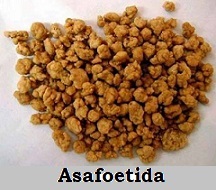 It has been in use since the days of Roman empire to prevent spasms and flatulence, and as an expectorant, laxative, and sedative. It helps in treating irritable bowel syndrome, gives relief from breathing difficulty due to bronchitis, swine flu, and asthma, helps in menstrual disorders, supports healthy blood sugar level and blood pressure and maintains cardiovascular health. In some traditional systems, it is used with jaggery to treat convulsions and mental disorders, and with ghee for sciatic pains.
It has been in use since the days of Roman empire to prevent spasms and flatulence, and as an expectorant, laxative, and sedative. It helps in treating irritable bowel syndrome, gives relief from breathing difficulty due to bronchitis, swine flu, and asthma, helps in menstrual disorders, supports healthy blood sugar level and blood pressure and maintains cardiovascular health. In some traditional systems, it is used with jaggery to treat convulsions and mental disorders, and with ghee for sciatic pains.
Caution: Traditional dose used beneficially for medicinal purpose is 0.2-0.5 g. Not advisable for pregnant women and infants, those having ulcers, gastrointestinal or bleeding disorders, epilepsy or BP issues, or 2 weeks before surgery.12-14
4. Red chillies (Lal mirch)/Paprika/Cayenne pepper
Red chillies/chilli pepper: In India there is a wide variety of red chillies in both dry and powder form, used in special rice preparations, curries, pickles, and chutney (pastes of herbs, vegetables, or lentils). It is a good appetiser. Rich in vitamins A, C & E, it can boost the immune system, keep eyes healthy, fight migraine, sinusitis, cold, and flu. Due to its chemical compound capsaicin 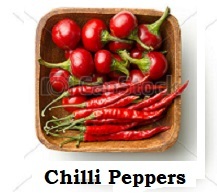 (responsible for the heat element in chillies), chilli pepper can prevent life threatening diseases and is used in ointments to give relief from pains, sprains, and numbness.
(responsible for the heat element in chillies), chilli pepper can prevent life threatening diseases and is used in ointments to give relief from pains, sprains, and numbness.
Paprika: Its taste can range from sweet to fiery. It is a unique ground spice that can be made from multiple kinds of peppers; sweet paprika is made primarily from ground red bell peppers which lack the chemical capsaicin but are high on vitamin A. Paprika is particularly known to aid in treatment of autoimmune conditions and prevent gastric cancer.
Cayenne pepper: An earthy pepper that would add a punch of heat to any recipe. Normally available in a dry or finely ground form, it is usually hotter than paprika and red chilli. It can particularly help in digestion, toothaches, seasickness, alcoholism, malaria, and fevers, regulate body metabolism, and give relief to those who have difficulty swallowing. Some trials and studies have shown that cream containing this pepper is very effective in treating psoriasis.
Caution: Apply 1-2 drops of oil on the palms and fingers before touching or handling this spice, and afterwards rub some lemon and then wash hands well before touching the face or eyes. Dosage depends on how much heat a person can bear. Not advisable if one has ulcer or acidity.15-18
5. Black Pepper/Peppercorns (Kaali mirch)
When half-ripe berries from the pepper plant are picked and dried, they shrivel and wrinkle, and become dark. These are Black peppercorns, called pepper when ground. Considered king of spices, all you need is a pinch per meal. It is an important 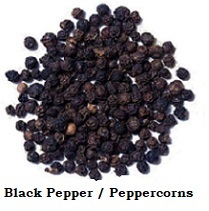 ingredient in cough and cold tonics, helps in curing stomach ulcers and vitiligo, and can prevent progression of tumour. Its active ingredient called piperine enhances cognitive brain functioning, fights depression, boosts absorption of nutrients, and improves gastrointestinal function.
ingredient in cough and cold tonics, helps in curing stomach ulcers and vitiligo, and can prevent progression of tumour. Its active ingredient called piperine enhances cognitive brain functioning, fights depression, boosts absorption of nutrients, and improves gastrointestinal function.
When the berries have totally ripened and their outer shell is removed (thus some nutrition is lost), these are called White peppercorns. Taste of white pepper is described as earthy and complex.
Caution: Excess intake may cause burning sensation in the throat or stomach.19-22
6. Coriander/Cilantro seeds (Dhaniya)
These are warm, sweet, and nutty seeds with a unique exotic flavour. Soak 1½ teaspoon of seeds overnight in two cups of 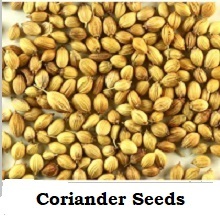 water, strain and drink as coriander tea, or just add it to your morning smoothie.
water, strain and drink as coriander tea, or just add it to your morning smoothie.
Studies have shown it lowers blood pressure as well as blood sugar, eases digestive discomforts like IBS, heals mouth ulcers and sores, and fights infections including UTI. It contains a natural compound, dodecanal, which is more powerful than an antibiotic and guards against food poisoning. The powerful seeds are known to support healthy menstrual function and prevent neuro diseases. 23,24
7. Fenugreek (Methi)
Used in curries, it has a pungent aroma with a fairly bitter taste that becomes pleasant on cooking. It can be roasted and ground to make coffee.
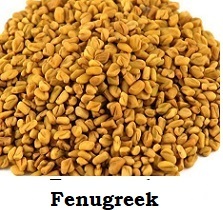 Rich in nutrients, it reduces inflammation (can also be used as a poultice), gives relief from mouth ulcers, boils, bronchitis, and chronic cough, and improves appetite, digestion, and constipation. Traditionally used to induce child birth, it improves lactation in breast feeding mothers, gives relief in menopause, enhances reproductive functions in men, and can greatly benefit athletic performance through increasing strength and helping with post workout recovery. Studies have shown that consumption of fenugreek seeds soaked in hot water can help in the treatment of type-2 diabetes.
Rich in nutrients, it reduces inflammation (can also be used as a poultice), gives relief from mouth ulcers, boils, bronchitis, and chronic cough, and improves appetite, digestion, and constipation. Traditionally used to induce child birth, it improves lactation in breast feeding mothers, gives relief in menopause, enhances reproductive functions in men, and can greatly benefit athletic performance through increasing strength and helping with post workout recovery. Studies have shown that consumption of fenugreek seeds soaked in hot water can help in the treatment of type-2 diabetes.
Caution: Pregnant women and those with bleeding disorders and on medication should avoid its use or consult their physician.25-27
8. Carom/Caraway seeds (Ajwain)
These have a pungent bitter taste and flavour and are added during cooking lentils, beans and some root vegetables like taro (colocasia) and potato to reduce flatulence; also in curries, pickles, and Indian bread. Good to roast dry or in ghee (clarified butter) to enhance its flavour.
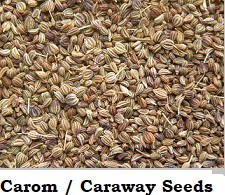 Well known home remedy for improving appetite and treating flatulence. Chew a few raw seeds after a meal to aid digestion. Tea made with roasted seeds, with little honey if needed, enhances body metabolism, burns fat, gives relief from cough, improves respiration and can reduce inflammation.
Well known home remedy for improving appetite and treating flatulence. Chew a few raw seeds after a meal to aid digestion. Tea made with roasted seeds, with little honey if needed, enhances body metabolism, burns fat, gives relief from cough, improves respiration and can reduce inflammation.
Caution: Unsafe for pregnant women.28,29
9. Nigella/black cumin (Kalonji)
These jet black seeds are dry roasted and added for their flavour and aroma to curries, vegetables, lentils, and to some pickles.
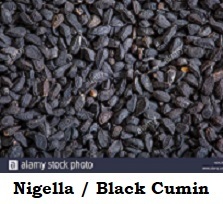 Extensive research on Nigella has revealed its miraculous healing power! So, it has been widely used in ancient and traditional medicine as antihypertensive, anti-diarrhoeal, liver tonic, appetite-stimulant, analgesic, antibacterial, diuretic, and for healing skin disorders. It can also give relief from allergic rhinitis. A handful of seeds heated with mustard oil can be applied to bring relief to an inflamed joint.
Extensive research on Nigella has revealed its miraculous healing power! So, it has been widely used in ancient and traditional medicine as antihypertensive, anti-diarrhoeal, liver tonic, appetite-stimulant, analgesic, antibacterial, diuretic, and for healing skin disorders. It can also give relief from allergic rhinitis. A handful of seeds heated with mustard oil can be applied to bring relief to an inflamed joint.
Caution: Normally 1 g (½ teaspoon) should suffice in cooking, though 0.3-0.5 g used in medicine has shown beneficial effects.30,31,32
10. Turmeric (Haldi)
This famous golden spice is available fresh or dried which can be ground into a fine powder. It has an earthy aroma, slightly peppery and bitter, with a subtle ginger taste, and blends well with other spices. It is considered a prized medicinal spice as its active ingredient is curcumin - a bright yellow natural phenol. As curcumin is fat-soluble, turmeric should be taken with a healthy fat (coconut 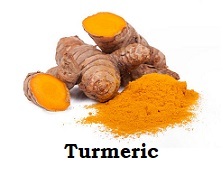 oil, olive oil, or ghee) and also with black pepper (as its piperine content enhances the bioavailability of curcumin by 20 times), for its best absorption by the body. Used alone, curcumin gets metabolised before it can get absorbed.
oil, olive oil, or ghee) and also with black pepper (as its piperine content enhances the bioavailability of curcumin by 20 times), for its best absorption by the body. Used alone, curcumin gets metabolised before it can get absorbed.
Due to its potent antioxidants, turmeric can fight diabetes, kill cancer cells and prevent their growth especially in breast, stomach, colon, pancreas, and skin, and prevent heart disease. It can effectively improve digestion, reduce depression, prevent blood clots, fight inflammation and treat arthritis, relieve pain, help with Alzheimer’s disease, and heal wounds and improve eczema, psoriasis, and acne. A study found that a chemotherapy drug was more effective at shrinking drug-resistant tumours, when used in combination with curcumin.
Caution: Larger amounts may lead to nausea and diarrhoea.33-38
11. Ginger (Adrak)
It has a peppery and a slightly sweet taste, with a pungent and spicy aroma. It goes well with many vegetables, salads, soup, and sauce. To get the most out of its nutrients, add ginger both at the beginning and the end of cooking a dish. Ginger cookies and ginger tea are a favourite with many. One of the top anti-inflammatory spices, it can settle an upset stomach, nausea, and vomiting, 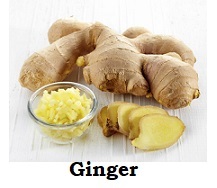 morning sickness in pregnant women, motion sickness, and pains especially in rheumatoid arthritis. Hot ginger water is a great soother during a cold, flu, or cough; its regular intake may keep them at bay. A study found that daily consumption of raw and heat-treated ginger helped in reducing exercise-induced muscle injury and pain. It can help in treating colon cancer too.
morning sickness in pregnant women, motion sickness, and pains especially in rheumatoid arthritis. Hot ginger water is a great soother during a cold, flu, or cough; its regular intake may keep them at bay. A study found that daily consumption of raw and heat-treated ginger helped in reducing exercise-induced muscle injury and pain. It can help in treating colon cancer too.
Therapeutic ginger tea: Boil a 2-inch piece of fresh grated ginger (without peeling its skin) in 2 cups of water for 10-20 minutes. Strain it well and add a pinch of other spices of choice like turmeric, black pepper, or cinnamon, along with a spoon of raw honey and juice of a half lemon to make a tasty ginger tea.
Caution: 1-2 teaspoons of grated or crushed ginger or paste is considered sufficient and safe. Decrease its intake if there is heartburn, diarrhoea, or stomach pain.39-41
12. Garlic (lahasun)
Though a bulb vegetable, it is used as a spice. High in certain sulphur compounds and filled with vital nutrients, it is intensely aromatic and flavourful, very pungent when eaten raw. It may be added to any dish sautéed, raw, roasted, baked, or cooked.
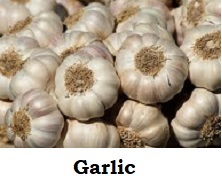 Fresh garlic contains an amino acid called alliin. When a clove of garlic is crushed or chopped, an enzyme, alliinase, is released. Alliin and alliinase interact to form allicin, which is considered the major biologically active component of garlic. Scientists suggest allowing garlic to stand for 10 minutes after chopping or crushing before cooking it, as allicin needs a few minutes to become active. Raw garlic gives the most benefits; cook it at below 140°F as higher temperatures will kill allicin. Best to add garlic when you have almost finished cooking a dish.
Fresh garlic contains an amino acid called alliin. When a clove of garlic is crushed or chopped, an enzyme, alliinase, is released. Alliin and alliinase interact to form allicin, which is considered the major biologically active component of garlic. Scientists suggest allowing garlic to stand for 10 minutes after chopping or crushing before cooking it, as allicin needs a few minutes to become active. Raw garlic gives the most benefits; cook it at below 140°F as higher temperatures will kill allicin. Best to add garlic when you have almost finished cooking a dish.
In the ancient and medieval times, it was revered for its medicinal properties. Grave diggers used crushed garlic as a protection against plague. During the two world wars, it was used as an antiseptic for wounds and to prevent infections like gangrene in soldiers. Considered a super spice next to turmeric, many studies on its benefits reveal its power in preventing major illnesses like heart disease, stroke, cancer, diabetes, and infections. It can control blood pressure, prevent common cold, hair loss, Alzheimer’s disease and dementia, fight fungus and treat athlete’s foot. Note: Garlic supplements hardly provide any benefits.
Caution: Use it in minimal amount, a clove of garlic a day is recommended for people who suffer from chronic or recurrent infections or low resistance to colds and flu. Those having low BP, ulcers, intestinal issues, and on blood thinners should consult their physician before consuming garlic. It is regarded by spiritual masters as a negative energy food for daily intake, except as a medicine, as it stimulates the nervous system in a big way; not advocated for serious spiritual seekers.42-46
Onion which is an edible bulb of the same family as garlic is a vegetable, though used like a spice due to its aroma (onions previously covered in 2 parts in vol 5 #1&2).
13. Anise/Fennel seeds (Saunf)
Anise and fennel seeds are from two different plants of the same family, and have similar flavour - sweet, mildly spicy, and aromatic. One can be a substitute for the other, though anise being stronger may be used in lesser quantity. Seeds, whole or powdered, are used in salads, pasta dishes, and vegetables; added to dough for baking cookies, in fruit fillings, hot chocolate or coffee, and also made as tea.
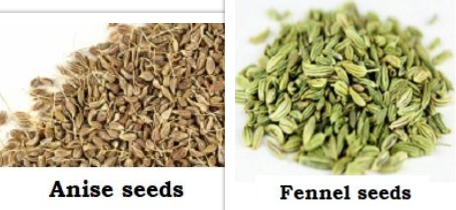 They are often chewed after a meal to freshen breath and to aid digestion. They can fight bacterial and fungal infections, treat stomach ulcers, and ease symptoms of menopause and depression. Studies show use of 5 gm as medicine improved postmenopausal symptoms. As a spice, ½ to 1 teaspoon should suffice.
They are often chewed after a meal to freshen breath and to aid digestion. They can fight bacterial and fungal infections, treat stomach ulcers, and ease symptoms of menopause and depression. Studies show use of 5 gm as medicine improved postmenopausal symptoms. As a spice, ½ to 1 teaspoon should suffice.
Star Anise (a star-shaped spice) should not be confused with Anise as it comes from a different family of plants but both have liquorice-like flavour with similar health benefits.47,48
14. Cardamom-Green (Elaichi), Black (Badi Elaichi)
Green cardamom: It has a unique flavour, with hints of lemon and mint, and its fragrance is nutty, spicy, citrusy, and sweet. As it needs to be harvested manually, it is labour intensive and very expensive. Remove the seeds from the pod and freshly grind for best effect. It is a popular additive in India in tea; also in savoury dishes, breads, pancakes, cakes and cookies, pies and puddings, 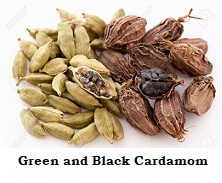 smoothies and desserts.
smoothies and desserts.
A natural breath freshener and an essential ingredient in some chewing gums, it is chewed after a heavy meal to aid digestion and cleanse the saliva to prevent bad breath and tooth decay. It helps in asthma and bronchial disorders and can lower blood pressure.
Black cardamom: It has a distinct smoky aroma and flavour. Rarely used in sweet dishes, this spice is used in cooking kidney beans, chickpeas, vegetables, curries, and special rice preparations.
Black cardamom helps in reducing various stomach ailments, common infections, and dental problems, and acts as a mouth freshener. In traditional Chinese medicine it was used to treat malaria.
Caution: Not more than 1 or 2 green cardamom per day for fresh breath and digestion is recommended, 1 black cardamom should suffice in cooking. Avoid using it if one has gallstones as it may trigger spasmodic pain.49-51
15. Clove (Laung)
It is a dried flower bud, intensely aromatic but pungent, with a sweet warm flavour, added to a number of savoury and sweet dishes.
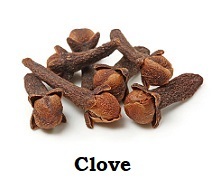 With high antioxidant count, it can prevent life threatening diseases like cancer. As a principal natural source of eugenol, a phenolic acid, it is anti-inflammatory, anti-mutagenic and antimicrobial and works as an antiseptic and analgesic, excellent for oral health, used in dental procedures and preparations, and gives relief from headaches. Ground cloves are applied to minor cuts for healing. In hot beverages, it can relieve congestion and cough.
With high antioxidant count, it can prevent life threatening diseases like cancer. As a principal natural source of eugenol, a phenolic acid, it is anti-inflammatory, anti-mutagenic and antimicrobial and works as an antiseptic and analgesic, excellent for oral health, used in dental procedures and preparations, and gives relief from headaches. Ground cloves are applied to minor cuts for healing. In hot beverages, it can relieve congestion and cough.
Caution: It is safe to take up to 15 whole cloves per day; avoid if prone to skin allergy or have a bleeding disorder.52-55
16. Cinnamon (Dalchini)
Derived from the brown bark of cinnamon trees, it has a sweet woody scent, with a warm and soothing fragrance. Ranked by researchers as world’s number one spice, it helps the body to absorb other spices better. It is added to desserts, beverages, and fruits. It is a natural food preservative and can stop discolouration of cut fruits and vegetables.
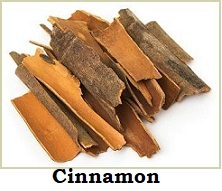 High in antioxidants, it is especially rich in fibre and manganese. It can fight inflammation, infections especially viruses, and allergies, decrease menstrual pain and stop excess bleeding, stabilise blood sugar, preventing spikes after a meal, maintain oral health, prevent candida in the digestive tract, clear respiratory passage when taken with ginger and pepper, especially in cold weather, and help in osteoporosis. Just smelling cinnamon or chewing cinnamon can boost brain activity.
High in antioxidants, it is especially rich in fibre and manganese. It can fight inflammation, infections especially viruses, and allergies, decrease menstrual pain and stop excess bleeding, stabilise blood sugar, preventing spikes after a meal, maintain oral health, prevent candida in the digestive tract, clear respiratory passage when taken with ginger and pepper, especially in cold weather, and help in osteoporosis. Just smelling cinnamon or chewing cinnamon can boost brain activity.
Caution: Taking up to a maximum of 6 g per day is considered safe. Higher intake may cause allergic reactions, mouth sores, liver problems, low blood sugar, and difficulty in breathing.56-59
17. Saffron (Kesar)
Derived from the separated and dried stigma of purple saffron flowers, this exotic aromatic spice is red in colour, with a pungent and slightly bitter taste. Growing and harvesting it is highly labour-intensive as more than a million flowers give only a pound of saffron; so, it is the most expensive spice and comes in very small quantities as saffron threads. It goes well with desserts and puddings, rice dishes, and vegetables lending a beautiful yellow-orange colour.
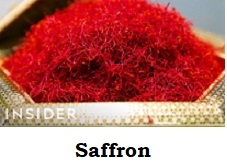 Traditionally used for gastrointestinal ailments and upper respiratory complaints, and to heal wounds, it has been particularly found effective in reducing anxiety, depression, hormonal disorders, hypertension, macular degeneration and improving cardiovascular health. It can reverse aluminium toxicity. With its predominant manganese content it is good for skeletal and thyroid health.
Traditionally used for gastrointestinal ailments and upper respiratory complaints, and to heal wounds, it has been particularly found effective in reducing anxiety, depression, hormonal disorders, hypertension, macular degeneration and improving cardiovascular health. It can reverse aluminium toxicity. With its predominant manganese content it is good for skeletal and thyroid health.
Caution: Buy from a reliable source! As per most studies on patients, it is considered safe to take as a medicine 30 mg per day for 6 weeks. High doses are reported to be toxic.60-62
18. Nutmeg/Mace (Javitri/Jaiphal)
Nutmeg and mace are siblings from the same fruit of nutmeg tree with different characteristics. Nutmeg is the dark coloured stone or seed within the fruit; mace is the red wrap around the stone. 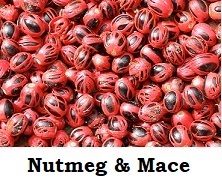 Known to be sweet and warm, both are used in baked savouries and sweet dishes. Mace is sweeter, milder, and subtler in taste and flavour. The benefits are similar.
Known to be sweet and warm, both are used in baked savouries and sweet dishes. Mace is sweeter, milder, and subtler in taste and flavour. The benefits are similar.
One teaspoon of honey with a full pinch of ground nutmeg/mace can help rid the body of kidney infection and stones. Mixed with water and a little ginger, it can settle the stomach and put an end to diarrhoea. It is good for stomach ulcers, oral health, soothing the nerves and treating insomnia as well as boosting heart, brain, and skin health.
Caution: It should be used sparingly, maximum up to 1 g; could become toxic at 5 g and affect the central nervous system.63-66
19. Allspice
Contrary to its name, it is a single spice made from dried berries. It looks like peppercorns, but the taste has a mix of pepper, clove, cinnamon, and nutmeg. It is used to flavour ginger breads, 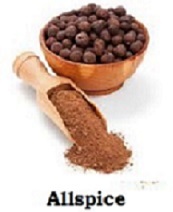 desserts, and beverages. Due to its sweetness, one can reduce the use of sugar. Tea made from allspice can relieve bloating and flatulence; poultice made from its powder can relieve pain. 67
desserts, and beverages. Due to its sweetness, one can reduce the use of sugar. Tea made from allspice can relieve bloating and flatulence; poultice made from its powder can relieve pain. 67
20. Popular Spice mixes
- Garam masala is a blend of ground spices used extensively in Indian cuisine. The mix generally consists of: cumin, coriander, dried red chilli, black and white peppercorns, fennel, cloves, cinnamon, black and green cardamom and mace. These may be roasted before grinding to release their aromas and flavours. All have to be carefully blended to have a balanced effect.68
- Panch phoron is a colourful blend of 5 whole spices - cumin, fenugreek, black mustard, nigella, and fennel seeds. The mix which originated from eastern part of India, is extensively used for making pickles. For cooking vegetables and lentils, the mix is first tempered in oil or ghee for special taste and flavour.69
Conclusion: Spices no doubt will impart colour, life, and zest, to our food making it delicious, help maintain our health, and protect us from many ailments, if used with understanding and care. As advised by Sri Sathya Sai Baba “take care to avoid excess of spices, chilli, and salt”.70
References and Links:
- Sathya Sai Speaks on “Vehicle care” to prevent illness, 16 October 1974, http://www.sssbpt.info/ssspeaks/volume12/sss12-48.pdf
- What is a spice: https://www.thespruceeats.com/what-are-spices-995747
- https://www.diffen.com/difference/Herbs_vs_Spices)
- Spices for life: http://www.ayurvedacollege.com/blog/ayurvedic-uses-spices-incredible-powerhouses-medicinal-benefits/
- Benefits of spices: https://www.ncbi.nlm.nih.gov/pmc/articles/PMC5030248/
- Mustard seeds: https://foodfacts.mercola.com/mustard-seed.html
- https://www.healthline.com/nutrition/is-mustard-good-for-you#nutrition
- Cumin Benefits: https://draxe.com/nutrition/cumin-seeds/
- Cumin Benefits & Caution: https://www.emedihealth.com/cumin-benefits.html
- Cumin Study: https://www.medicalnewstoday.com/articles/319562
- Cumin tea: https://food.ndtv.com/health/15-incredible-benefits-of-jeera-water-for-your-skin-hair-and-health-1644227
- Asafoetida: https://draxe.com/nutrition/asafoetida/
- https://www.emedicinehealth.com/asafoetida/vitamins-supplements.htm
- https://www.ayurtimes.com/hing/
- Red Chili: https://www.gyanunlimited.com/health/top-5-health-benefits-of-chilli-the-queen-of-spices/2755/
- Paprika: https://draxe.com/nutrition/paprika/
- Different peppers: https://www.masterclass.com/articles/whats-the-difference-between-cayenne-pepper-paprika-red-chili-pepper-and-ground-red-pepper-plus-15-red-pepper-varieties-and-culinary-uses
- Cayenne: https://draxe.com/nutrition/cayenne-pepper-benefits/
- Black pepper benefits: https://www.emedihealth.com/black-pepper-benefits.html
- Black pepper: https://www.24mantra.com/blogs/organic-lifestyle/top-6-health-benefits-of-black-pepper/
- Healthy black pepper study: https://www.ncbi.nlm.nih.gov/pubmed/23768180
- Black/white/red pepper: https://draxe.com/nutrition/black-pepper-benefits/
- Coriander seed: https://draxe.com/nutrition/coriander/
- https://food.ndtv.com/food-drinks/7-amazing-coriander-seeds-benefits-from-tackling-diabetes-to-improving-the-skin-1407915
- Fenugreek: https://draxe.com/nutrition/fenugreek/
- https://www.emedihealth.com/fenugreek-benefits.html
- https://foodfacts.mercola.com/fenugreek.html
- Carom: https://www.healthline.com/nutrition/carom-seeds
- https://food.ndtv.com/food-drinks/9-super-benefits-of-ajwain-the-multi-talented-household-spice-1438699
- Nigella: Miraculous healing powers studied: https://www.ncbi.nlm.nih.gov/pmc/articles/PMC3642442/
- https://food.ndtv.com/food-drinks/10-incredible-health-benefits-of-nigella-seeds-kalonji-1456233
- https://www.verywellhealth.com/nigella-sativa-89064
- Turmeric: https://healthcare.utah.edu/healthfeed/postings/2020/02/turmeric.php
- https://food.ndtv.com/food-drinks/what-is-the-difference-between-turmeric-and-curcumin-1657211
- https://www.ncbi.nlm.nih.gov/pmc/articles/PMC5664031/
- https://foodfacts.mercola.com/turmeric.html
- https://draxe.com/nutrition/turmeric-curcumin-benefits/
- https://www.hopkinsmedicine.org/news/publications/johns_hopkins_health/summer_2013/a_simple_spice_that_may_battle_cancer
- Ginger: https://foodfacts.mercola.com/ginger.html
- https://draxe.com/nutrition/ginger-tea-benefits/
- https://www.ncbi.nlm.nih.gov/books/NBK92775/
- Garlic: https://draxe.com/nutrition/7-raw-garlic-benefits-reversing-disease/
- https://www.thespruceeats.com/all-about-garlic-995693
- https://health.clevelandclinic.org/6-surprising-ways-garlic-boosts-your-health/
- Garlic a negative energy food!: https://www.youtube.com/watch?v=VBEOjcUDeFM; https://www.youtube.com/watch?v=so3rT66Hx7E
- Ayurvedic view on garlic/onion: https://www.thehealthsite.com/diseases-conditions/heres-why-a-no-onion-garlic-diet-is-recommended-in-ayurveda-bs0416-388694/
- Anise/Fennel: https://www.thespruceeats.com/what-is-anise-995562
- Anise: https://draxe.com/nutrition/anise-seed/
- Cardamom: https://draxe.com/nutrition/cardamom/
- https://foodfacts.mercola.com/cardamom.html
- Black cardamom: https://www.thespruceeats.com/badi-elaichi-black-cardamom-1957875
- Cloves: https://www.organicfacts.net/health-benefits/herbs-and-spices/health-benefits-of-cloves.html
- https://www.prohealth.com/library/clove-valuable-spice-thats-used-centuries-89015
- https://www.thespruceeats.com/substitute-for-whole-and-ground-cloves-4153883
- Clove, a powerful antioxidant: https://draxe.com/essential-oils/clove-oil-uses-benefits/
- Cinnamon: https://draxe.com/nutrition/health-benefits-cinnamon/
- https://foodfacts.mercola.com/cinnamon.html
- https://www.drugs.com/npp/cinnamon.html
- https://www.organicauthority.com/health/11-health-benefits-of-cinnamon
- Saffron: https://draxe.com/nutrition/saffron/
- https://foodfacts.mercola.com/saffron.html
- https://www.drugs.com/npp/saffron.html
- Nutmeg/mace: https://thespiceguide.com/mace-vs-nutmeg-whats-the-difference/
- https://thespiceguide.com/15-amazing-health-benefits-for-nutmeg/
- https://draxe.com/nutrition/nutmeg/
- https://www.drugs.com/npp/nutmeg.html
- Allspice: https://www.thespruceeats.com/what-is-allspice-p2-995556
- Garam masala: https://en.wikipedia.org/wiki/Garam_masala
- Panch Phoron: https://www.tarladalal.com/glossary-panch-phoron-1027i
- Food for a healthy body and mind: Sathya Sai Baba Speaks on Food, September 2014 edition, page 65, sourced from Sathya Sai Newsletter, USA, Vol28-3,(May-June 2004)
_________________________________________________________________________________________________________________________________________________
2. AVP workshop, Puttaparthi, India, 23-29 February 2020
Conducted by senior teachers 10375 & 11422, this intense one-week workshop was attended by 11 enthusiastic participants from India and abroad ((South Africa, Gabon, & Indonesia). Additionally 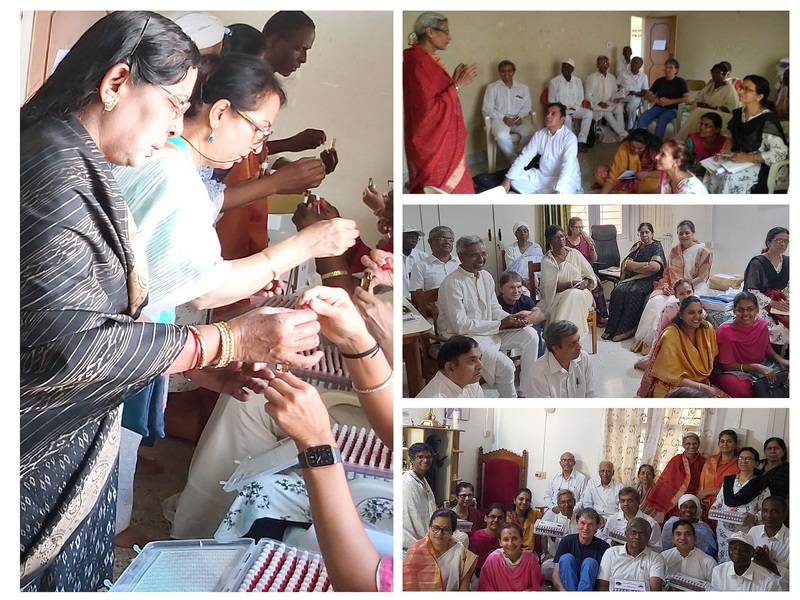 four overseas practitioners (France, Gabon, Canada & Ireland) participated in order to refresh and update their knowledge, one of whom 03578 volunteered as French translator. The workshop was geared to provide practical training through both mock and live clinics as well as demos and role play by teachers and senior practitioners 11578 & 11964. This livened the atmosphere and helped to make the concepts clear. While giving her inputs on case history writing, Hem Aggarwal stressed the importance of supporting the case studies with photographs where possible. Dr Jit Aggarwal in his inaugural address prompted the attendees to think why they were in the workshop. Based on his personal interactions with Swami, he explained what is selfless seva, quoting actual incidents. He also shared how the SRHVP machine was blessed and Swami’s inspiring words that Vibrionics is the medicine of the future, but cautioned the practitioners not to make tall claims about vibrionics, thus raising expectations in the minds of patients. He said ‘let the remedy speak for itself and this will inspire confidence in your patients’. In his valedictory address, he summarised that to become a good practitioner, one needs to take a professional approach and at the same time work with a heart filled with love and compassion.
four overseas practitioners (France, Gabon, Canada & Ireland) participated in order to refresh and update their knowledge, one of whom 03578 volunteered as French translator. The workshop was geared to provide practical training through both mock and live clinics as well as demos and role play by teachers and senior practitioners 11578 & 11964. This livened the atmosphere and helped to make the concepts clear. While giving her inputs on case history writing, Hem Aggarwal stressed the importance of supporting the case studies with photographs where possible. Dr Jit Aggarwal in his inaugural address prompted the attendees to think why they were in the workshop. Based on his personal interactions with Swami, he explained what is selfless seva, quoting actual incidents. He also shared how the SRHVP machine was blessed and Swami’s inspiring words that Vibrionics is the medicine of the future, but cautioned the practitioners not to make tall claims about vibrionics, thus raising expectations in the minds of patients. He said ‘let the remedy speak for itself and this will inspire confidence in your patients’. In his valedictory address, he summarised that to become a good practitioner, one needs to take a professional approach and at the same time work with a heart filled with love and compassion.
________________________________________________________________________________________________________________________________________________________
3. Covid-19 – Global response from Sai Vibrionics Practitioners
The pandemic situation caused by the outbreak of the Covid-19 virus has created unprecedented challenges. In early February 2020 when the first death from this virus took place outside China, we started to get enquiries from some practitioners in Europe and the vibrionics research team soon realised that the best way to handle this virus would be to boost the immunity of people, so an “Immunity booster” remedy was made to act as a prophylactic on 12 February and this was circulated to those who had made enquires. It was widely circulated to all our practitioners through the newsletter published on 1 March. From early March the situation worldwide started to deteriorate and on 11 March the WHO declared Covid-19 as a pandemic. Our research team swung into action and on 12 March, had carefully put together remedies for treatment of Covid-19; this update was immediately sent to all practitioners. With more information coming from all corners of the world, we understood more about how the virus was affecting the body. So this time, our research team responded with an enhanced combo for prevention and the same to be used for treatment but at a higher dosage; so 2nd update was sent out on 20 March. Now we were getting daily feedback and inputs from practitioners around the globe and finally a third update was issued on 13 April to include a remedy further refined.
We share with you the limited number of reports received so far.
India: Practitioners all over India were able to dispense the remedy to their regular patients, their family members, and in Medical Camps before the national lockdown. After the lockdown they started dispensing as per guidelines of the third update of 13 April. At the time of going to press, according to recorded feedback from twelve states in India, 42,903 individuals are taking Immunity booster! There are valid reasons to believe that the number would be much more as many practitioners have not sent their data and reports are still coming.
Outside India: Out of a total of 80 countries where we have practitioners, we have received reports from only 19, that too from just a handful of practitioners in some countries. A total of 5,088 preventive remedy bottles were given out; USA (1504), UK (1001), Poland (628), Benin (480), France (427), Slovenia (295), Croatia (175), Russia (124), Greece (102), Argentina (78), Uruguay (76), Gabon (48), Romania (45), South Africa (44), Peru (29), Spain (13), Belgium (10), Luxembourg (6), and Mauritius (3).
A total of 131 patients who were either tested positive or had strong Covid-19 symptoms were treated, some through broadcasting. Practically all of them recovered completely within 2 weeks but majority within one week and at least 26 within 2-4 days. One patient in ICU when his treatment started and although improving, is still in the ICU. The general experience was that where treatment was started immediately on the onset of Covid-19 symptoms, the remedies worked very fast. In three cases, patients developed symptoms while they were on preventive dosage of OD, but when dosage was increased the symptoms started receding and they recovered quickly.
We have received quite a few inspiring tales of how so many practitioners have put themselves forward to bring joy back into the lives of many. We hope to share these with you at a later date.
Samastha Lokah Sukhino Bhavantu! May all beings in all the worlds be happy and free!
Om Sai Ram
